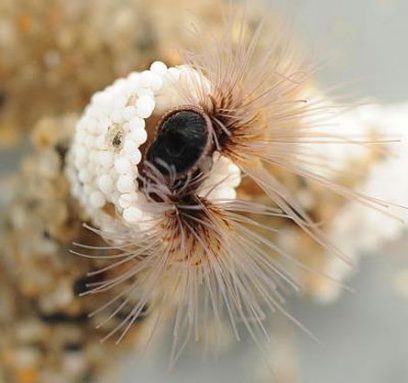Worm glue
A glue similar to the one made by sandcastle worms may one day paste together bones in the human body
 |
|
This sandcastle worm lives in the laboratory where scientists can study it. The worm built its house in the lab from small white beads instead of bits of shell and sand. Scientists have created a glue similar to the worm’s glue that may one day be used in bone surgery.
|
| Russell Stewart |
Scientists often look to the natural world for inspiration and ideas. Now, we may be able to thank an unusual worm for a new kind of superglue.
At the University of Utah in Salt Lake City, scientists have created a powerful adhesive that works underwater and hardens quickly, which means it may be useful inside the human body. Most glues don’t work well inside the body, where everything is wet. When surgeons operate on a person to repair broken bones, for example, they may be able to use the new glue to hold the bones together.
The Utah scientists were inspired to make the new glue by a little sea animal called the sandcastle worm. It lives on the coast in an area between the water levels for high and low tides. During high tide, their homes are underwater; when the tide goes out, their homes are left high and dry.
This sea creature gets its name from its house. A sandcastle worm builds its own house by collecting grains of sand, broken shells and other debris and stacking these bits all around. The worm also produces a glue that is used to stick all these pieces together, forming a solid tube. The worm’s glue hardens underwater in less than 30 seconds, and within a few hours the glue gets tough like leather.
Russell Stewart, one of the scientists who worked on the new glue, says that in the same way the sandcastle worm glues together grains of sand, surgeons may be able to glue together broken bones. The worm “literally glues skeletons together underwater, so we thought it would be a good model for wet surgery,” he says.
Stewart, who is a bioengineer at the University of Utah in Salt Lake City, and his colleagues set out to understand the worm’s adhesive, so they could then make their own. First, they studied the sandcastle worm’s glue in the laboratory. They found many proteins, which are tiny molecules that are the construction material of most living things. The researchers learned which proteins give the glue its super-sticking power by studying the proteins’ structures. Half the proteins had strong positive or negative electric charges. Positive and negative charges are attracted to each other and stick together, and this helped make the glue extra sticky.
Once they identified and understood the proteins, the scientists made their own version of the glue in the laboratory. They tested their creation and found that it worked underwater—and was about twice as strong as the worm glue. Further tests showed that the glue isn’t poisonous to human cells.
At the end of the experiment, the scientists had invented a new superstrong glue that worked underwater and was not toxic, which means it didn’t cause harm. These three qualities—strong, working underwater, nontoxic—could make the glue an important part of surgeries in the future. Plus, researchers are now looking at ways to make the glue able to dissolve, which means that over time, as the bones healed, the glue would disappear.
Stewart and his team may have found a new way to help bones heal—all because of a funny little worm on the beach.







